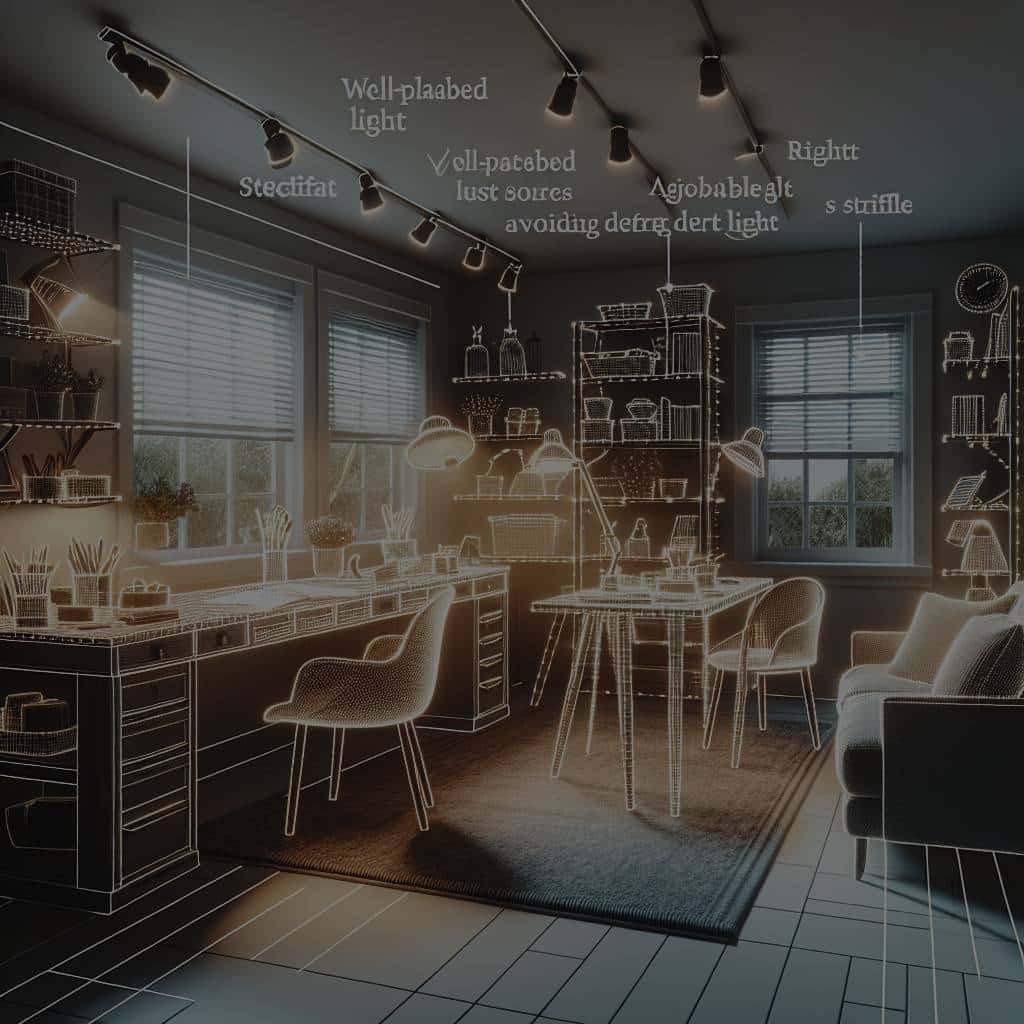What’s the Best Lighting Design for a Home Craft Room to Reduce Eye Strain?

As you dive into the world of crafting, whether it’s sewing, painting, or paper mâché, having an optimized workspace is essential for your creativity and productivity. One crucial aspect that often gets overlooked is the lighting design of your home craft room. Ideal lighting can make a significant difference, not just in the quality of your work, but also in reducing eye strain. Let’s explore how you can create a lighting design that illuminates your workspace effectively, enhances your craft experience, and takes care of your eyes.
Choosing the Right Task Lighting
Task lighting is a primary component for any workspace, and a craft room is no exception. It is customized lighting that directs light to specific areas where detailed tasks are performed.
Avez-vous vu cela : How Can You Create a Stylish and Functional Space for a Freelance Makeup Artist at Home?
When you’re working on intricate tasks such as sewing or beading, good task lighting will illuminate your work area, reducing the strain on your eyes. Opt for adjustable lamps with brightness control. LED lights are a great choice as they offer bright, cool light and are energy-efficient. Consider floor lamps or desk lamps with swing arms that can be adjusted as per your task.
To reduce shadows on your work area, place the light source on the side opposite your dominant hand. For example, if you’re right-handed, your lamp should be on the left side of your work table.
A lire aussi : How to Develop an Organized System for Seasonal Home Decor Storage?
Importance of Natural Lighting
While artificial lighting plays a crucial role, do not underestimate the power of natural light. It can significantly improve the brightness and ambiance of your craft room.
Strategically placed windows can offer an abundance of natural light to your workspace, creating an inviting and inspiring environment. Natural light is softer than artificial light, reducing eye strain and providing a more accurate color perception, crucial for craft tasks such as painting or fabric selection.
If your room doesn’t boast large windows, consider using mirrors to enhance the natural light. Position a mirror opposite the window to reflect light around the room.
Creating a Balanced Lighting Design
A balanced lighting design combines different types of lighting to create a well-lit, functional space.
Your craft room should have a mix of ambient, task, and accent lights. Ambient lighting offers general illumination for the room. This can be achieved through overhead lights, chandeliers, or wall sconces.
Task lighting, as mentioned earlier, focuses light on specific work areas. Accent lighting, on the other hand, is used to highlight specific areas or objects, like a display of your craftwork or bookshelves.
LED strip lights can be an excellent option for accent lighting. They can be placed under shelves or around mirrors to enhance the aesthetics of your room and also provide additional lighting.
Lighting and Room Décor
The lighting in your craft room should complement the room’s décor. Choose lamp designs that blend well with the room’s aesthetics.
If your room has a minimalist design, opt for sleek, modern lamps. For a more vintage look, go for lamps with antique finishes. Remember, your craft room is a reflection of your personal style. The lighting fixtures can add to the room’s personality while also being functional.
The color of your walls can also influence the room’s lighting. Light colors reflect light, making the room brighter, while dark colors absorb light, making the room appear darker. If you have the flexibility, choose lighter paint colors for your craft room to enhance the light.
Storage and Lighting
Your craft room likely houses a myriad of tools and materials. Proper storage is essential to keep your workspace tidy and functional.
Consider using illuminated storage solutions. LED lights can be installed inside drawers or cabinets to help you quickly find what you need. If you have open shelving, under-shelf lights can illuminate your supplies without taking up additional space.
Ensuring proper lighting design in your craft room can make a significant difference in your crafting experience. It can enhance the functionality of your workspace, improve the quality of your work, and most importantly, reduce eye strain. By combining the right task lighting with natural light, creating a balanced lighting design, and considering the room décor and storage, you can create an ideal craft room that fuels your creativity without compromising on your comfort and well-being.
Perfecting Your Sewing Room Lighting
The right lighting can make a world of difference when it comes to your sewing space. When stitching, threading a needle, following a pattern, or sorting through your thread collection, having well-distributed light is essential to not only improve your work quality but prevent eye strain.
Your sewing machine should have its own task light. Many modern machines come with built-in LED lights. If yours does not, consider adding an attachable sewing machine light. These lights are typically adjustable, allowing you to direct the light exactly where you need it.
Moreover, additional task lighting would be beneficial. A table lamp with a moveable arm or a magnifying lamp can provide focused light on your work surface, especially for intricate tasks. LED lights are recommended as they provide bright, cool light and are energy-saving.
When setting up your task lighting, consider the position of your sewing machine and the direction of your work. If you’re right-handed, place the task light to the left of your machine to avoid casting a shadow with your hand or the machine itself.
Overhead lighting is a crucial part of the interior design of your sewing room. It should provide good lighting without creating too much glare or shadows. Recessed ceiling lights or a well-placed chandelier can provide a generous amount of light. To avoid creating shadows on your work area, consider using multiple sources of overhead light.
Another way to enhance the lighting in your sewing room is by using reflective surfaces. If you have a light-colored table or work surface, it can help reflect light and brighten up the room. Mirrored or metallic surfaces can also be used to reflect light and make the room appear brighter.
Ensuring Lighting Comfort in Your Home Office
Just like your craft room, good lighting is crucial in your home office to reduce eye strain, especially if you’re working on a computer for extended periods.
The most crucial aspect is the placement of your screen. Avoid facing windows directly to prevent glare on your screen. Instead, position your computer parallel to a window, allowing natural light to come from the side.
When it comes to artificial light, a combination of overhead lighting and task lighting works best. Overhead lighting should ideally be indirect to avoid glare on the screen. LED ceiling lights are a good option as they provide bright, diffused light.
For task lighting, consider adjustable desk lamps with brightness control. They can provide focused light on your work surface, helping you read documents or take notes without straining your eyes. Remember to place your task light on the opposite side of your dominant hand to prevent casting shadows.
Consider adding a floor lamp in a corner of your room for soft, ambient lighting. It can help reduce the contrast between your screen and the surrounding area, making it easier on your eyes.
Just like in your craft room, the color of your walls can influence the room’s lighting. Lighter colors can make your home office appear brighter and more spacious, while dark colors can make it seem smaller and darker.
Conclusion
Creating an ideal craft room or home office involves more than just the right furniture and storage solutions. The lighting design plays a crucial role in enhancing your workspace’s functionality, improving your work quality, and reducing eye strain.
Whether you’re setting up a sewing room or a home office, remember to incorporate a mix of natural light, overhead lighting, and task lighting. Consider your room’s interior design, including the color of your walls, to enhance the light.
With the right lighting design, your craft room or home office can be a space that fuels your creativity and productivity without compromising on your comfort and well-being.
